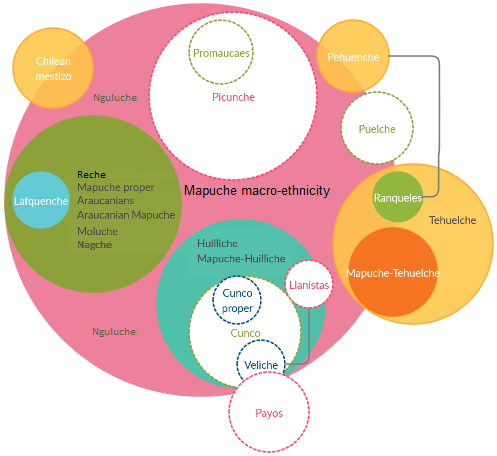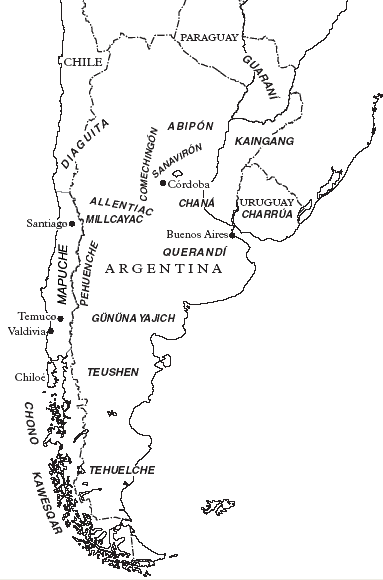|
Ranquel
The Ranquel or Rankülche are an indigenous tribe from the northern part of La Pampa Province, Argentina, in South America.Tapia, Alicia Haydée"Archaeological Perspectives on the Ranquel Chiefdoms in the North of the Dry Pampas, in the Eighteenth and Nineteenth Centuries: Abstract."''International Journal of Historical Archaeology.'' (retrieved 5 July 2011) With Puelche, Pehuenche and also Patagones from the Günün-a-Küna group origins, they were conquered by the Mapuche. Name The name ''Ranquel'' is the Spanish name for their own name of Rankülche: ''rankül'' -cane-, ''che'' -man, people- in Mapudungun; that is to say "cane-people" History In the late 18th and early 19th centuries, the Ranquel controlled two chiefdoms in Argentina. Between 1775-1790 a group of Pehuenche advanced from the side of the Andes mountains east to the territory they called ''Mamül Mapu'' (''mamül'': kindling, woods; ''mapu'': land, territory) as it was covered by dense woods of '' Prosopis cal ... [...More Info...] [...Related Items...] OR: [Wikipedia] [Google] [Baidu] |
Yanquetruz
Yanquetruz (or Llanquetruz) (died 1838) was a famous Ranquel warrior who fought the Europeans in the pampas of what is now Argentina in the early nineteenth century. Early years Yanquetruz's family had ruled over the region from the cordillera to the Atlantic from around 1680 to 1856, but his authority was confined to the Ranqueles. The Ranquel people, a Mapuche tribe, were led by a chief named Máscara Verde (Green Mask) in 1812. Yanquetruz came to these people from Chile in 1818. He had a reputation as a great warrior, and taught them techniques of war, making the Ranquel warriors known throughout the pampas. The men of fighting age were organized into bands of between ten and thirty people whose leader obeyed the command of the Ranquel chief. When Máscara Verde died, Yanquetruz was elected to take his place. His first major assault was made on the settlers in Salta Province, helped by Chilean allies under a leader named Carreras. The Indian attacks were ferocious, and they g ... [...More Info...] [...Related Items...] OR: [Wikipedia] [Google] [Baidu] |
Mapudungun
Mapuche ( , ; from 'land' and 'people', meaning 'the people of the land') or Mapudungun (from 'land' and 'speak, speech', meaning 'the speech of the land'; also spelled Mapuzugun and Mapudungu) is either a language isolate or member of the small Araucanian family related to Huilliche spoken in south-central Chile and west-central Argentina by the Mapuche people. It was formerly known as Araucanian, the name given to the Mapuche by the Spanish; the Mapuche avoid it as a remnant of Spanish colonialism. Mapudungun is not an official language of Chile and Argentina, having received virtually no government support throughout its history. However, since 2013, Mapuche, along with Spanish, has been granted the status of an official language by the local government of Galvarino, one of the many communes of Chile. It is not used as a language of instruction in either country's educational system despite the Chilean government's commitment to provide full access to education in Mapu ... [...More Info...] [...Related Items...] OR: [Wikipedia] [Google] [Baidu] |
Mapuche
The Mapuche ( , ) also known as Araucanians are a group of Indigenous peoples of the Americas, Indigenous inhabitants of south-central Chile and southwestern Argentina, including parts of Patagonia. The collective term refers to a wide-ranging ethnicity composed of various groups who share a common social, religious, and economic structure, as well as a common linguistic heritage as Mapudungun speakers. Their homelands once extended from Choapa River, Choapa Valley to the Chiloé Archipelago and later spread eastward to Puelmapu, a land comprising part of the Pampas, Argentine pampa and Patagonia. Today the collective group makes up over 80% of the Indigenous peoples in Chile and about 9% of the total Chilean population. The Mapuche are concentrated in the Araucanía (historic region), Araucanía region. Many have migrated from rural areas to the cities of Santiago and Buenos Aires for economic opportunities, more than 92% of the Mapuches are from Chile. The Mapuche traditional e ... [...More Info...] [...Related Items...] OR: [Wikipedia] [Google] [Baidu] |
Tehuelche People
The Tehuelche people, also called the Aónikenk, are an Indigenous people from eastern Patagonia in South America. In the 18th and 19th centuries the Tehuelche were influenced by Mapuche people, and many adopted a horseriding lifestyle. Once a nomadic people, the lands of the Tehuelche were colonized in the 19th century by Argentina and Chile, gradually disrupting their traditional economies. The establishment of large sheep farming estates in Patagonia was particularly detrimental to the Tehuelche. Contact with outsiders also brought in infectious diseases ushering deadly epidemics among Tehuelche tribes. Most existing members of the group currently reside in cities and towns of Argentine Patagonia. The name "Tehuelche complex" has been used by researchers in a broad sense to group together Indigenous peoples from Patagonia and the Pampas. Several specialists, missionaries and travelers have proposed grouping them together on account of the similarities in their cultural trai ... [...More Info...] [...Related Items...] OR: [Wikipedia] [Google] [Baidu] |
Conquest Of The Desert
The Conquest of the Desert () was an Armed Forces of the Argentine Republic, Argentine military campaign directed mainly by General Julio Argentino Roca during the 1870s and 1880s with the intention of establishing dominance over Patagonia, inhabited primarily by Indigenous peoples in Argentina, Indigenous peoples. The Conquest of the Desert extended Argentine territories into Patagonia and ended Chilean expansion in the region. Argentine troops killed more than 1,000 Mapuches, displaced more than 15,000 more from their traditional lands and enslaved a portion of the remaining Indigenous people. Argentines of European descent, Settlers of European descent moved in and developed the lands through irrigation for agriculture, converting the territory into an extremely productive area that contributed to the status of Argentina as a great exporter of agricultural products during the early 20th century.''The Argentine Military and the Boundary Dispute With Chile, 1870-1902,'' George ... [...More Info...] [...Related Items...] OR: [Wikipedia] [Google] [Baidu] |
Cuarto River
The Cuarto River (, 'Fourth River'), also known as the Saladillo River, is a river of Argentina which crosses the southern part of the Province of Córdoba Province (Argentina), Córdoba, and merges with the Tercero River to form the Carcarañá River (a tributary of the Paraná River via the Coronda River). The Cuarto River is also known as ''Cochancharava'', the name given to it by the Ranquel Indians. The name Saladillo is generally used for the lower course, below the ''Bañado del Río Saladillo'' wetland. See also * List of rivers of Argentina * Río Cuarto, Córdoba References Rivers of Argentina Rivers of Córdoba Province, Argentina Tributaries of the Paraná River {{Argentina-river-stub ... [...More Info...] [...Related Items...] OR: [Wikipedia] [Google] [Baidu] |
Juan Manuel De Rosas
Juan Manuel José Domingo Ortiz de Rozas y López de Osornio (30 March 1793 – 14 March 1877), nicknamed "Restorer of the Laws", was an Argentine politician and army officer who ruled Buenos Aires Province and briefly the Argentine Confederation. Born into a wealthy family, Rosas independently amassed a personal fortune, acquiring large tracts of land in the process. Rosas enlisted his workers in a private army, private militia, as was common for rural proprietors, and took part in the disputes that led to numerous Argentine Civil Wars, civil wars in his country. Victorious in warfare, personally influential, and with vast landholdings and a loyal private army, Rosas became a caudillo, as provincial warlords in the region were known. He eventually reached the rank of brigadier general, the highest in the Argentine Army, and became the undisputed leader of the Federales (Argentina), Federalist Party. In December 1829, Rosas became governor of the province of Buenos Aires and e ... [...More Info...] [...Related Items...] OR: [Wikipedia] [Google] [Baidu] |
Mendoza Province
Mendoza (), officially the Province of Mendoza, is a province of Argentina, in the western central part of the country in the Cuyo region. It borders San Juan to the north, La Pampa and Neuquén to the south, San Luis to the east, and the republic of Chile to the west; the international limit is marked by the Andes mountain range. Its capital city is the homonymous city of Mendoza. Covering an area of 148,827 km2, it is the seventh biggest province of Argentina with 5.35% of the country's total area. The population for 2022 is 2,014,533 inhabitants, which makes it the fifth most populated region of the country, or 4.38% of the total national population. History Pre-Columbian times Archeological studies have determined that the first inhabitants in the area date from the Holocene, but there are few remains of those people to know their habits. The earliest sites of human occupation in Mendoza Province, Agua de la Cueva and Gruta del Indio, are 12,000–13,000 years o ... [...More Info...] [...Related Items...] OR: [Wikipedia] [Google] [Baidu] |
Santa Fe Province
The Invincible Province of Santa Fe (, , lit. "Holy Faith") is a Provinces of Argentina, province of Argentina, located in the center-east of the country. Neighboring provinces are from the north clockwise Chaco Province, Chaco (divided by the 28th parallel south), Corrientes Province, Corrientes, Entre Ríos Province, Entre Ríos, Buenos Aires Province, Buenos Aires, Córdoba Province, Argentina, Córdoba, and Santiago del Estero Province, Santiago del Estero. Together with Córdoba and Entre Ríos, the province is part of the economico-political association known as the Center Region (Argentina), Center Region. Santa Fe's most important cities are Rosario (population 1,193,605), the capital Santa Fe, Argentina, Santa Fe (369,000), Rafaela (100,000), Reconquista, Santa Fe, Reconquista (99,000) Villa Gobernador Gálvez (74,000), Venado Tuerto (69,000), and Santo Tomé, Santa Fe, Santo Tomé (58,000). Demonym Citizens of the province are known as ''santafesinos'' (fem. ''santafes ... [...More Info...] [...Related Items...] OR: [Wikipedia] [Google] [Baidu] |
La Pampa Province
La Pampa () is a sparsely populated province of Argentina, located in the Pampas in the center of the country. Neighboring provinces are from the north clockwise San Luis, Córdoba, Buenos Aires, Río Negro, Neuquén and Mendoza. History In 1604 Hernando Arias de Saavedra was the first European explorer to reach the area; it was later explored by Jerónimo Luis de Cabrera in 1662. But it was not until the 18th century that Spanish colonists established permanent settlements here. Resistance of the local indigenous people prevented much expansion until the government of Juan Manuel de Rosas. It did not cease until Julio Roca's conquest of the desert in the 19th century. The territory was divided between the officers, and they erected the first Argentine settlements. The ''Territorio Nacional de La Pampa Central'' was erected in 1884, containing the Río Negro Province and parts of other surrounding provinces. It had around 25,000 inhabitants. By 1915 there were 110,000 r ... [...More Info...] [...Related Items...] OR: [Wikipedia] [Google] [Baidu] |
Desert Campaign (1833–34)
The Western Desert campaign (Desert War) took place in the deserts of Egypt and Libya and was the main theatre in the North African campaign of the Second World War. Military operations began in June 1940 with the Italian declaration of war and the Italian invasion of Egypt from Libya in September. Operation Compass, a five-day raid by the British in December 1940, was so successful that it led to the destruction of the Italian 10th Army (10ª ) over the following two months. Benito Mussolini sought help from Adolf Hitler, who sent a small German force to Tripoli under Directive 22 (11 January). The ( Erwin Rommel) was formally under Italian command, as Italy was the main Axis power in the Mediterranean and North Africa. In the spring of 1941, Rommel led Operation Sonnenblume, which pushed the Allies back to Egypt except for the siege of Tobruk at the port. At the end of 1941, Axis forces were defeated in Operation Crusader and retired again to El Agheila. In early 1942 A ... [...More Info...] [...Related Items...] OR: [Wikipedia] [Google] [Baidu] |







